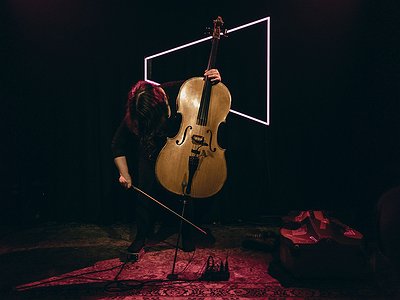Part 1
Names: Marja Ahti, Judith Hamann
Occupation: Sound artist, composer (Marja Ahti), cellist, composer (Judith Hamann)
Nationality: Swedish (Marja), Australian (Judith)
Recent release: Marja Ahti & Judith Hamann's A coincidence is perfect, intimate attunement is out via Second Editions.
Over the course of their career, Judith Hamann has worked with a wide range of artists, including Oren Ambarchi, Toshimaru Nakamura, The Necks, Wadada Leo Smith, Anthea Caddy, Lori Goldston, and Joshua Bonnetta.
[Read our Oren Ambarchi interview]
[Read our Toshimaru Nakamura interview]
[Read our Tony Buck of The Necks interview]
[Read our Wadada Leo Smith interview]
[Read our Anthea Caddy interview]
[Read our Lori Goldston interview]
[Read our Joshua Bonnetta interview]
[Read our Peter Knight of Australian Art Orchestra interview]
If you enjoyed these thoughts by Marja Ahti & Judith Hamann and would like to find out more about their work, visit their respective websites: Marja Ahti; Judith Hamann.
To keep reading, visit our earlier Marja Ahti interview and our interview with her about sound.
On paper, there are many contrasts between your respective approaches. And yet, the album has a wonderful coherency to it which feels like a natural extension of either of your work. How did you start talking and thinking about collaborating and what were points that made it seem like a good idea?
Marja Ahti: In retrospect it seems that our collaboration has been the fortunate result of a series of coincidences. I had invited Judith to play a concert in Turku in the spring of 2020 as they were in residency on an island off Helsinki. But then lockdown isolated us in our respective locations - close, yet far.
I was invited by Fielding Hope at Café Oto to record something for their Takuroku series and I had the idea to ask Judith to do it with me. Not being able to meet, but still sharing sounds and ideas from our respective locations. That’s how we started to work on Portals, by sending each other recordings and overdubs. It felt good to have something to work on together in a time of such distress.
Judith Hamann: Marja and I were finally able to meet in person in Turku at the end of my time in Finland. I remember a feeling of familiarity (perhaps as much in the sense of familial, or relational connection as in the sense of something ‘known’) as a result of this process of working together. By the time we were able to be in the same place in physical form I felt we had created, through this listening correspondence, a really particular sense of connection, of shared hearing and thinking.
So it also felt very natural to continue this practice of sending recordings to each other which eventually formed ‘A coincidence…’, even as borders opened and our lives began to move in different paces and geographies.
Since tuning and attunement is a sort of a theme for this album, what is your take on it? Do you personally have a deeper interest in alternative tuning systems?
Judith Hamann: I suppose that over many years, tuning practices have become a really central part of my work, and this is something that happened sort of slowly and stealthily. I went to study with Charles Curtis in San Diego and the work we did together on tuning, especially the work around La Monte Young’s music, deeply changed the way I play, and the way I listen. Just intonation opened a very special space to consider sound and pitched material otherwise: as a relational practice, as a community practice, and as an activity of care.
There is something very beautiful about the collectivity of finding, sustaining, and shifting intervals together, as a form of shared navigation. The kind of slow, more research-based work that I have the great fortune to do now with the Harmonic Space Orchestra in Berlin, has again added new layers to this approach. It asks something very different of you than, say, euro-classical heritage ways of considering harmony.
Working with whole number ratios in harmonic space for me is very much about relationships rather than hierarchy, or external systems of measure. To me, each interval, as you get to know them, has its own properties: character, texture, physicality, and presence.
I think that the idea of attunement, in the sense Marja and I are considering it, speaks to many of these ideas, and yet maps them in different ways – onto recorded sounds – offering the material we are gathering and exchanging a similar relational approach. The tuning in this sense is not necessarily about pitch per se, but about finding the ways in which sounds might speak to each other, or form new composite spaces and how to build a shared relational language within a field of recorded sound.
Marja Ahti: To continue on Judith’s thread here, I think of attunement as our receptivity and reactiveness to another person, to sound, to the world. It involves a cultivation of attention, an attitude of responsiveness and a willingness to resonate, to be in tune, in harmony. Working with detailed sound, you attune your attention to your instrument, to the nuances of tone interaction, to the timbre of a sounding object, the grain and resonance of a sounding environment or to feelings or sensations that arise with them, for example.
At the most basic level, I think of attunement as the very ground of openness to life. From that vantage point everything is coinciding, corresponding, falling together.
Judith’s work with intonation is so inspiring, so full of attention and care. Not being an instrumentalist myself, working with pitch relations has mainly been focused on electronic sound as well as the subtle harmonies you find unfolding in so many urban landscape recordings and in structure-born sound through different materials.
For a long time, I was mainly interested in intuitive tuning, finding beatings, undulations and harmonics by ear without the rational framework. During the past couple of years I’ve also been learning about ratios to see if it opens up new ways of being with sound.
The liner notes mention “Recordings & correspondences” between 2020 and 2022. We can now listen to some of the recordings - what were the correspondences about?
Marja Ahti: I actually consider the recordings as such as the correspondence, responding to sound with sound. But of course we were also commenting on each other’s recordings, discussing structure, pacing, mood and so forth in writing. Thinking about themes and poetics. Keeping each other updated on our whereabouts, keeping company.
Judith Hamann: I also consider the sounds as their own form of correspondence, like a sort of practice of letter writing but via recordings, a method of both communication and also a way of holding someone in your thoughts you know?
When you hear something that it makes that person and their environment seem closer to yours, or that this sound might speak to something you’ve received, but also in the sense that correspondence can be about a deepening or building of something: the way experience and memory coalesce over time in that practice of setting aside that very specific space of communication, that they build a body of knowledge, or a relational body between correspondents.
Portals and A coincidence is perfect, intimate attunement are clearly taking place within a similar space, and yet they each have their distinct identity. How do they relate, do you feel?
Marja Ahti: One thing that sets them apart is that the former was made during one or two months during lockdown, quite specific to those particular locations that we were in, and the later while travelling and in the midst of many other activities. A coincidence is perfect, intimate attunement was a slower process that spanned almost two years of changing seasons.
During the recording of Portals I was simultaneously working on my solo album Still Lives and both of these albums had a focus on what was immediately present in my home surroundings, to hear very familiar things in new ways, as if for the first time. Working with Judith on that near-yet-far distance, opening a window into her listening added even more of this sense of newness.
As we continued our collaboration, new layers were added. To me, A coincidence is perfect, intimate attunement has a different sense of time and space, creating other kinds of connections between seemingly remote events and locations. The red thread is a more elusive sense of synchronicity, yet still embedded in the passing of the seasons and the everyday.
Judith Hamann: For me, there feels a difference in energy as a result of the time span and modes of living during their making, perhaps it is that the aperture of A coincidence is perfect, intimate attunement is much broader in both time, distance, and the movement or navigation of the correspondence.
Portals was, from my end anyway, very much planted in one location: getting to know in a deep way this island I found myself on in Finland and also there was this distinct and visible material of connection between Marja and I of the Baltic sea, of being in the same country although separated. ‘A coincidence…’ seems to me to have more of a sense of movement as an activity, in the way it moves between these co-created spaces.
It also holds a distinct sense of time and distance, stretching and collapsing over these specific frames of measure: both in terms of more marked spaces like shifts in seasons, alongside more slippery things to pinpoint like feeling, thought, interior places.






